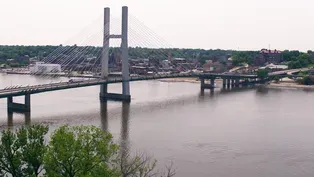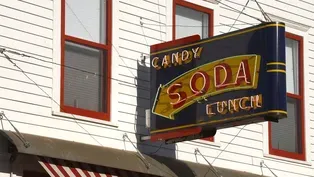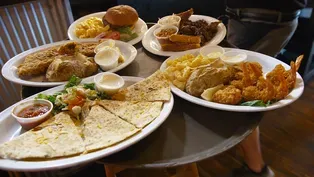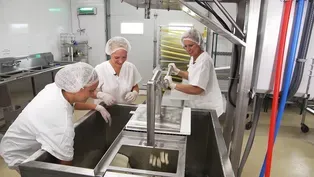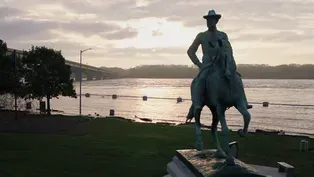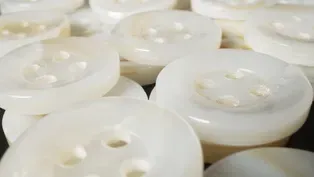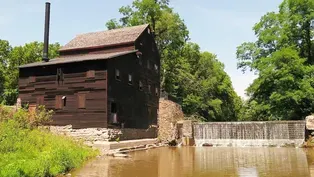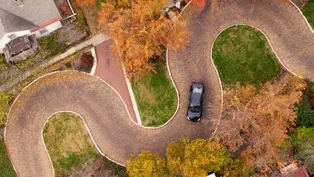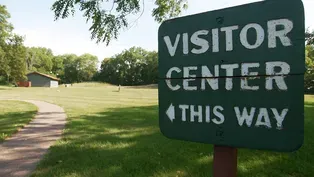
Great River Road National Scenic Byway - South
Season 1 Episode 106 | 26m 46sVideo has Closed Captions
Discover Iowa’s charm and beauty along the southern portion of the Great River Road.
Travel Iowa’s southern portion of the Great River Road from Muscatine to Keokuk. Explore the natural beauty, charming river towns and hidden gems along the way.
Problems with Closed Captions? Closed Captioning Feedback
Problems with Closed Captions? Closed Captioning Feedback
Road Trip Iowa is a local public television program presented by Iowa PBS

Great River Road National Scenic Byway - South
Season 1 Episode 106 | 26m 46sVideo has Closed Captions
Travel Iowa’s southern portion of the Great River Road from Muscatine to Keokuk. Explore the natural beauty, charming river towns and hidden gems along the way.
Problems with Closed Captions? Closed Captioning Feedback
How to Watch Road Trip Iowa
Road Trip Iowa is available to stream on pbs.org and the free PBS App, available on iPhone, Apple TV, Android TV, Android smartphones, Amazon Fire TV, Amazon Fire Tablet, Roku, Samsung Smart TV, and Vizio.
Providing Support for PBS.org
Learn Moreabout PBS online sponsorshipKohlsdorf: On this episode of "Road Trip Iowa," we're traveling Iowa's southern portion of the Great River Road.
It's kind of fun.
It just takes a little muscle.
Kohlsdorf: From Muscatine to Keokuk, we'll explore the natural beauty, charming river towns and sweet spots along the way.
Man: Two scoops of chocolate and a medium strawberry shake.
Kohlsdorf: Next on "Road Trip Iowa."
Woman: Kwik Star is proud to be a part of Iowa communities across the state.
Family owned for over 50 years, we're dedicated to treating our guests, employees, and communities as we would like to be treated.
Man: Musco Lighting is an Iowa company that travels across the U.S. and to more than 125 countries to light community recreation fields, stadiums, airports, monuments, and more.
While our reach is global, we're committed to our local communities.
♪♪ ♪♪ ♪♪ The Great River Road is a National Scenic Byway stretching 3,000 miles along the Mississippi River from Minnesota all the way down to the Gulf of Mexico.
Today, we travel 90 miles of River Road in southeast Iowa from Muscatine to Keokuk.
Let's take a look at our itinerary.
We'll visit the oldest working gristmill between the Mississippi and the Rockies, get an aerial view of an ancient burial site, stop at a riverside restaurant where the views are as good as the food, and help make some of the best cheese curds in the state.
The river takes center stage on this journey, but we're starting with dessert first at a sweet little spot in Wilton.
♪♪ What can I get for you?
♪♪ Man: Two scoops of chocolate and a medium strawberry shake.
When you have someone that walks in the door that just says, oh, and their eyes light up and they say.
It's just like I remember 20 years ago when I came in here.
They haven't changed a thing.
They just have this comfort, but joy at the same time.
It's just -- it's just amazing.
When we were little kids, my grandma, on our birthdays, my grandma would walk us downtown and she walk us down to the Candy Kitchen.
Lynn: Here's our ice cream that's here if you want.
You want something?
We always say in some of our advertising a step back in time, and we're old fashioned service meant something.
And I think that's what we still try to provide today.
This building was built in 1856.
It was one of the first buildings built in Wilton.
There was a soda fountain put in here at some point after that, we suspect probably in the 1880s.
And then Gus Nopoulos actually reopened that soda fountain that had been in here and closed, and he reopened it in 1910 as the Candy kitchen.
It's just been here forever, and it's been an icon in the community.
I mean, the Nopoulos family running it since 1910, you know, has established for this community a consistency, which is amazing.
♪♪ And we spent a lot of time here with George and Thelma Nopoulos over the years, helping Thelma with lots of projects.
When it came time that this was, there was something to happen to the Candy Kitchen, where George Nopoulos died in 2015, Thelma didn't know what to do and she thought about tearing the building down and just liquidating everything.
And that's when Brenda to step in, but Thelma always kind of wanted it to be just left intact.
And that was our promise that we would leave it intact and celebrate the legacy of this family.
You said black raspberry?
Today I got a -- what is it?
It was a black and white, you know?
And because I said, boy, that looks good.
What's that?
It was good.
[ Laughs ] It was good.
I thought, oh my, that that's pretty rich for an old lady.
You know?
Brenda: I love making the banana split probably because it does take a little bit more time, but it's almost artistic.
I love to make a drink, a soda, a phosphate.
And the reason I like that is because in the menu we have, I don't know how many different flavors we have that we can make.
I love that experimentation.
Does that taste like 7 Up?
-It's better.
-It's better.
Oh, perfect.
It's a nice place to come and take the kids.
You know, without the Candy Kitchen -- the little ones love to have you come down and have an ice cream.
If you want to experience something that's truly unique that you don't see every day and really is the foundation of all other restaurants you've ever been to, come to a place like this.
Thank you guys.
Thanks for coming.
We'll see you next time.
♪♪ ♪♪ Kohlsdorf: On the eastern side of Wildcat Den State Park rests a National Historic Landmark that has sat on Pine Creek since 1848.
♪♪ The Pine Creek Grist Mill is thought to be the oldest working mill on its original site between the Mississippi River and the Rockies.
The Pine Creek Grist Mill is the third mill that was built by Muscatine County's first official settler, Benjamin Nye.
He would put his thumbs in his suspenders and -- and claim to everyone in "town" that this was going to be the finest mill ever constructed, and it obviously is, because 175 years later, she's still standing.
♪♪ In the middle of the 19th century, there were between 400 and 450 grist mills throughout the state, and now this is the only operating grist mill left.
But the importance of preserving it is to show people the state of the art, the state of the economy for settlers coming into the Wisconsin territories at the time before Iowa became a state and to show them how life was, how business was transacted from an agricultural standpoint.
Kohlsdorf: Visitors can experience firsthand how the mill operates, take a splash in the creek below, stroll across 150 year old bridge and explore unexpected geological wonders.
Pappas: In Wildcat Den State Park, there are several hidden gems that the state has to offer the public.
In the center of the park itself is a 300-million-year-old sea coral rock formation that actually served as the bed of an inland prehistoric ocean.
Obviously, the ocean has gone away now, but the coral formations that are left behind are truly stunning.
Shoppa: The park itself is beautiful.
It's a beautiful place to come out and rest and relax and reconnect, and there's so many things to see if you just slow down and are willing to take it in.
♪♪ ♪♪ Kohlsdorf: Throughout history, the Mississippi River has been a resource for industries such as agriculture, transportation and even textiles.
In the late 19th century, buttons, that's right.
buttons for clothing were punched from mussel shells harvested from the river.
They were called pearl buttons, and by 1905, Muscatine, Iowa had become known as the Pearl Button Capital of the world.
Joy: The button industry, in a very real sense, was started by one man, a guy named John Bevel.
He was a German immigrant.
Pearl buttons were not a novelty then.
They were a status symbol.
So he was sent a shell by a family member from the Mississippi River.
And he realized this is exactly what he needed to go into business.
And he moved to kind of a leap of faith.
He moved to the U.S., ultimately settling here in Muscatine, and he started making a few buttons on this machine right over here, actually.
This is his design.
This was in 1891.
By 1905, they're making 1.5 billion buttons here, 14 years later.
Kohlsdorf: Today, the National Pearl Button Museum tells the story of the entrepreneurs, the laborers and the mussels that put Muscatine on the map.
Joy: We have exhibits about all of Muscatine history.
In fact, even to this day, we're kind of the de facto history museum in Muscatine.
You're going to find something interesting.
You will be fascinated by some aspect of this place.
Kohlsdorf: What better way to button up a trip down the Great River Road?
♪♪ ♪♪ South of Muscatine, on the north bank of the Iowa River, rests an ancient grouping of burial mounds.
♪♪ This National Historic Landmark known as Toolesboro Mounds is home to some of the best preserved remnants of the Hopewell culture, a native society dating back as early as 200 BC.
Archaeological evidence indicates that there were at least 20 burial mounds here.
There are seven that remain.
There's a lot of wonder.
There's a lot of kind of sparking of interest.
There's a lot of wow, I had no idea that this was here.
It's important to maintain this just as a reminder of the past.
We're always interested in where we came from, and this is remnants of people that lived here before European contact.
Kohlsdorf: Visitors can explore the mounds by hiking the expansive prairie plots, or by checking out the historical exhibits at the Visitor Center.
Artz-McComb: If you are traveling under the context of the Great River road, this is just one of the many cultural sites along the way, and depending on how far you're traveling, you're going to be able to put this into context with Cahokia in Saint Louis, with what you might have seen in northeast Iowa and Effigy Mounds.
You're going to be able to kind of put it all together, and the picture of both cultural and historic resources that you're going to see along the Great River Road.
♪♪ Next, we're headed to Burlington for its historic and revitalized riverfront District.
If you're a motorist who loves a challenge, head over to Snake Alley, one of the crooked streets in the world.
♪♪ Constructed in 1894 by German immigrants.
Snake Alley in downtown Burlington is made of limestone and blue clay bricks.
♪♪ This winding path is over 200 feet long and has 1,100 degrees of turning radius, earning its nickname as the crookedest street in the world.
Despite its historic significance, Snake Alley is open to the public.
Pull off in Burlington for your own driving adventure.
♪♪ Situated high on the bluffs overlooking Burlington, Mosquito Park may be the smallest park in town, but it has the biggest and most beautiful views along this stretch of river.
♪♪ Below, the riverfront welcomes travelers with culinary and cultural delights.
♪♪ Billups: So it's a beautiful town, both during the day and at night.
Burlington is known for its downtown architecture.
In fact, it's all lit up at night, so it's beautiful when you come over the bridge.
Seeing all our church steeples and buildings lit up, the Great River Bridge is lit up Kroll: There's just so much more than there was.
These old buildings are being revitalized and they're cool, you know?
♪♪ Billups: We have a lot of big city amenities and a lot of big city attractions, but still small town living, so it's great.
There is just something unique about Burlington.
It kind of sits down in this little valley right on the Mississippi River.
Billups: It almost has like a Nashville feel.
On a Friday night, there was live music and venues, and you could pop in and out, walk the whole way with our well-lit streets.
Then plus, we have the other activities like the arts.
We have a strong arts and music program throughout the city, like Civic Music and the Municipal Band.
The play is every Sunday.
You'll see the Memorial Auditorium, which we have a lot of outdoor and indoor events over the years.
You'll see our splash pad, which is new, our new park like environment.
And then as you move forth, we have a great riverfront park along with the marina and our North Dock capabilities.
So we're truly a boating town.
♪♪ Kohlsdorf: Whether you're docking a boat or parking a car, be sure to stop by this musical gem that's been in business since the eight track.
Weird Harold's has thousands of vinyl records filling two stories of this century old building in downtown Burlington.
I love it when they go upstairs and they see there's, you know, 50,000 records up there.
I love it when they look through that and say, wow, I've never seen a collection this big.
I've been working here since the summer of 1994.
I discovered my love of music when I started working here.
People are amazed by the vast amount of stuff we have in here.
It's unique shop because not only do we have the records and the paraphernalia that goes with the records, but my wife's business is attached right to it.
Hers is an art store, so she has a gallery and picture framing and that kind of thing.
So they kind of work well together.
I find that people who like art usually like music.
In fact, right now I love seeing the resurgence of actual album art.
Danny: There's a lot of unique things going on here.
[ Bell dinging ] ♪♪ Kohlsdorf: After a busy day of exploring, we head to The Drake for a unique dining experience with river views that are unmatched.
Constructed in 1906, this three-story brick building was once home to Drake Hardware.
Today, the name remains and The Drake is a must stop for hungry travelers.
Jennison: We've got a great view of the Mississippi River and the Great River Bridge.
The bridge lights up at night.
We've got about 160 chairs out here.
We want people to come down, come down this river, Scenic River Road and come by and see us.
This is the place to be.
I've probably been coming here the last 20 years or so.
It's been a go to spot for me.
It's got a lot of energy.
The patio is wonderful.
The environment is great.
It's right next to the Mississippi River.
If you're a river rat, it's a great place to dock and come in and eat.
Jim: That's good.
We smoke our own meats.
We've got a real wood fire grill.
We can do a little bit of pasta.
We do some great pizza dishes.
We've got salmon, tuna, shrimp, barbecue brisket.
We've got 16-ounce ribeyes cooked on our wood fire grill to die for.
Leinbach: I usually get fajita salad, but their appetizers are really good.
The duck fritters are one of my favorites also.
I really enjoy the salmon and broccoli.
Second would probably be the steak.
My favorite undoubtedly is the ribs.
The ribs are as good as they come anywhere.
Word spreads.
And yes, people come off of the interstate to come here to eat.
Kohlsdorf: Sam Jennison should know good food.
He revitalized this riverfront property and opened The Drake in the early 2000, before passing the baton to his son, Jimbo.
This is the special tonight.
Shrimp and baked potato.
The reactions I get from a lot of people, they're kind of surprised to kind of found this little gem right here in little old Burlington, Iowa, okay?
Because you come off this exit ramp and the first thing you see is The Drake restaurant, our patio all these cool umbrellas and this really neat spot to stop by and have a drink and/or some eats.
You'll get excellent service, you'll have a great time, and you'll enjoy the food and you'll enjoy Jimbo.
He's always around.
And he -- there's not a time that goes by that he doesn't at least say hi at least once.
Thank you, ma'am.
Come see us, folks.
We got room for you, and we can show you a good time, okay?
♪♪ Kohlsdorf: Next, we head south through the town of Fort Madison.
Named for our fourth president, James Madison, Fort Madison is located on one of the widest sections of the Mississippi River that is still used as a trading route today.
Let's head west on Highway 2 for a detour into the southern Iowa Hills.
♪♪ I'm here at Hinterland Dairy, just outside Donaldson in southeast Iowa.
Sitting on 400 rolling acres in Lee County, Hinterland is a family farm that's quickly gained a reputation for its handmade farmstead cheese.
Let's go take a look at their operation.
♪♪ First, we're catching up with Ralph Krogmeier, whose dairy and cheese operation has truly become a family affair.
So, Ralph, you've been in the dairy business most of your life, right?
That is correct.
I was raised on a dairy farm, but not this dairy farm.
Going through high school, I always had an interest in the dairy operation.
But after getting away from the dairy farm, going to college and working a lot of other jobs, the old cows didn't smell so bad after all.
The Krogmeiers started their Lee County dairy farm in 1979 and currently have over 150 cows.
We kind of like our numbers where we're at here.
So instead of adding more numbers to the cows, we decided to add more value to our milk.
And that's what we did In 2017, Ralph and his family set out to diversify their operation by creating their own dairy products.
The Krogmeiers constructed a new facility at a separate location to make their dream a reality.
Alright, so we are walking into your new dairy parlor, right?
Right.
Tell us a little bit about it.
Well, when we decided to pursue making cheese and adding value to our dairy products, we built this parlor to, obviously, you got to have milk to make cheese.
It was designed by Iowa State University Extension.
It's a DIY project.
A young man that was working for us at the time was taking the welding program at the local community college.
So he did most of all the fabrication here.
Where does the milk go from here?
We have a thousand gallon bulk tank.
It's a refrigerated tank, so the milk is cooled down.
And then from there we go to our pasteurizer and then to our cheese vat when we go to make cheese.
So usually we milk the evening before we make cheese the next day.
So it's fresh.
[ Laughs ] Yeah, it's fresh.
It's going to be walking around if it's much fresher.
Yeah.
♪♪ We're catching up with Ralph's daughter, Shannon, who has already begun the three-step process of making Hinterland's famous farmstead cheese curds.
So this is the third process, right in cheesemaking.
Walk us through what you're doing right now.
Yes, this is the beginning of the cheddar process.
It's what makes a true cheddar cheese or a true cheddar cheese curd.
So we have cooked the curd like Little Miss Muffet.
We had our vat full of whey and cheese curds, and it cooked for about an hour and a half at 102 degrees.
We've now drained off the whey, and the cheese curds, the little bitty particles like cottage cheese are sticking back together.
♪♪ Alright, so tell us what you're doing right now.
I am flipping the loaves of cheese, and I'm stacking them on top of each other to gently put a little pressure on that bottom loaf.
If you'd like to start with this end one here.
And so just flip it?
Yes.
Now you can say you're a cheese maker.
I am officially.
Uh-huh.
After flipping the cheese loaves three times, we wait for the whey to drain, which is reused in the field for the cows.
Alright, Brooke.
And now we're ready to mill the loaves of cheese into cheese curds.
Okay.
Here we go.
I'll do a few to get you started.
Show me how it's done.
Here we are.
Are you ready?
Okay.
I think so.
It's kind of fun.
Just takes a little muscle.
Okay.
[ Grunts ] Am I doing it right?
Yeah.
If you put a little more bouncing it helps a little bit.
There you go.
Okay, so just pound it.
Okay.
Yep.
Pound it.
That takes a little more -- less energy They do make electric, automatic ones.
Then you won't burn calories.
Right.
Okay, this is so satisfying.
You know, it's like you feel accomplished.
So we've milled the curds.
Now we're salting them, and then they'll be ready for packaging and enjoying his fresh cheddar cheese curds.
It's all done here.
It's all done here.
♪♪ Brooke, would you like to try a fresh cheddar cheese curd?
Um, yes, please.
Okay, so which one?
Does it matter?
Any one.
They're all okay.
I've never had fresh.
Woman: They are the best like that.
Oh, my gosh.
Yeah it's really salty in a good way.
-Mh-hmm.
-And squeaky.
And that's like a good mark, right, of curds?
Yes, if they're fresh and they squeak.
Mmm, okay.
Kohlsdorf: With the cheese process complete, let's head over to the farm store to hear from Shannon's mom Colleen about the different kinds of cheeses available at Hinterland.
We first started making cheese curds That was our very first product out, original, and then we have a few varieties of those.
And then we have our hard cheeses.
We have Franklin Road, which is our mild cheddar cheese.
Brook's Place is our aged, medium to sharp cheddar cheese and our fresh spreadable quark.
And that is kind of like a cream cheese spread.
We make that in original, garlic and herb and also the honey cinnamon flavors.
In 2023, Hinterland Dairy was recognized statewide when their cheese curds were named Best of Show at the Iowa State Fair, making this stop a worthy detour off the Great River road.
Colleen, thanks so much for showing us around Hinterland and telling us all about your cheese.
It's been a pleasure Well, thank you very much.
I appreciate you visiting today.
♪♪ ♪♪ The sunrise can be breathtaking at Iowa's southernmost city.
Nestled at the state's extreme southeast corner, Keokuk symbolizes the end of the road, or just the beginning for travelers exploring the Great River Road in Iowa.
♪♪ ♪♪ The Great River Road National Scenic Byway is the perfect way to discover the history and culture along the mighty Mississippi, right here in Iowa.
We grabbed a sweet treat at a classic soda fountain.
Learn the history of pearl buttons on the Mississippi, stopped at one of Iowa's smallest parks and toured a vibrant and revitalized riverfront.
We hope you discovered something new on the Great River Road.
If so, come out and see it for yourself.
For more on the history, culture and landscapes along Iowa's scenic byways, join us next time on "Road Trip Iowa.
♪♪ ♪♪ ♪♪ Woman: Kwik Star is proud to be a part of Iowa communities across the state.
Family owned for over 50 years, we're dedicated to treating our guests, employees, and communities as we would like to be treated.
Man: Musco Lighting is an Iowa company that travels across the U.S. and to more than 125 countries to light community recreation fields, stadiums, airports, monuments, and more.
While our reach is global, we're committed to our local communities.
Video has Closed Captions
Situated on the bluffs along the river, this town is known for its commerce and culture. (2m 57s)
Video has Closed Captions
The Candy Kitchen in Wilton is one of the oldest ice cream and soda parlors in the state. (3m 17s)
Video has Closed Captions
The Drake restaurant offers a unique dining experience with views that are unmatched. (2m 37s)
Video has Closed Captions
This family farm has quickly gained a reputation for its handmade, farmstead cheese. (6m 38s)
Video has Closed Captions
Explore the story of how mussel shells put Muscatine on the world map. (1m 49s)
Pine Creek Grist Mill at Wildcat Den State Park
Video has Closed Captions
Built in 1848, this mill is one of the oldest working mills west of the Mississippi River. (2m 37s)
Video has Closed Captions
This drivable path is 200 feet long and is claimed by some to be the crookedest street in the world. (48s)
Toolesboro Mounds National Historic Landmark
Video has Closed Captions
Travel the grounds of these burial mounds that date back to 200 B.C.E. (1m 43s)
Providing Support for PBS.org
Learn Moreabout PBS online sponsorshipSupport for PBS provided by:
Road Trip Iowa is a local public television program presented by Iowa PBS
